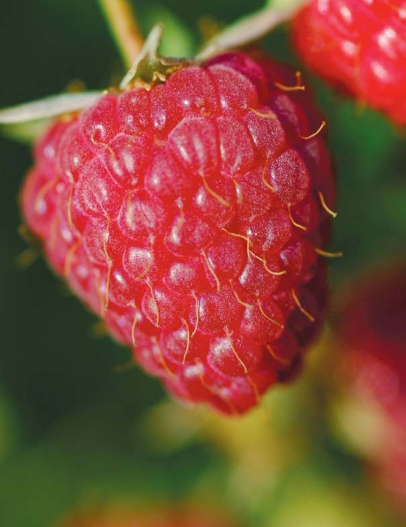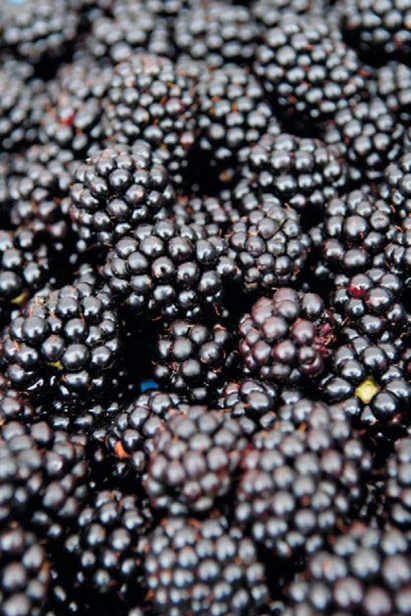Grown Wild: Into the Bramble
When I was a kid in elementary school, summertime had its pleasures. School was out, the YMCA pool was open and wild berries were in season. My closest friends and I would exit the confines of the pool’s fences in search of sweet fruits growing along the wood’s edge. We exited those bramble patches with our fingers sticky and our bellies full. We hid our harvesting activities from other classmates with code words, saving all the berries for ourselves. One girl claimed to understand our invented language. Yet she never joined us, nor did any other competing groups form to harvest from our patches. Only the birds were willing to work alongside three determined girls in the brambles.
Years later, while working in the ecology field, I’d learn that we most frequently encountered wineberry (Rubus phoenicolasius), a species native to Asia. It is most easily recognized by its red stems covered in red spines and coarse hairs. Wineberry fruits are sticky and bright red. Its foliage is tripartite (three leaflets making up one larger leaf) and hairy. The undersides of the leaves are silvery-grey with spines along the veins.
A less common find of my childhood pickings was black raspberry (Rubus occidentalis), also called black caps. We’d find this native wild bramble alongside wineberries—in hedgerows, abandoned fields, open woods and forest edges.
Black cap raspberries look like blackberries with several distinctions. True to their name, when black caps are harvested the fruit is hollow or cap-like. Black cap stems are purplish to light greenish with a whitish, waxy coating, while blackberries have reddish, fluted stems. Lastly, black cap foliage is tripartite, like that of the wineberry, while blackberry foliage is five-parted.
Wild blackberries (most commonly Allegheny blackberry, Rubus allegheniensis) can be found throughout New Jersey. I’ve noticed the flavor of blackberries is inconsistent— sometimes bland or bitter, other times sweet. Less-flavorful blackberries can be made into a pleasant syrup, but I do make note of where the best-tasting blackberry patches are.
Two lesser-known blackberry species, Northern dewberry and bristly dewberry (Rubus flagellaris and R. hispidus), can be found in dry fields or moist habitats, respectively. These smalled-fruited blackberries act like a ground cover. They exhibit a unique trait shared by many Rubus species, the ability to root at the growing tip, creating a field of prickly trip wires. Although they are usually not sweet, I can be found picking the pea-sized fruits in season for a snack.
Botanically speaking, raspberries and blackberries are members of the rose family. The magenta rose-like blooms of purple flowering raspberry (Rubus odoratus) reveal this connection. The plant bears large, maple-like leaves on stems free of prickles. The fruits are delicious, but drier and seedier than cultivated raspberries. Nevertheless, this shrub has the greatest beauty of all New Jersey native raspberries and blackberries. Purple flowering raspberry is found in striking natural areas along rich, moist forest edges and rocky bluffs.
The most rewarding native raspberry is greyleaf red raspberry (Rubus idaeus ssp. strigosus), a close relative of the beloved European red raspberry (Rubus idaeus). My family plans a trip to the Catskills during peak wild raspberry (purple flowering and greyleaf red) season. We travel our favorite trails slowly, combing every shrub for berries. Usually, we return to the cabin with full bellies.
For those who’d rather saunter to the garden than hike to a wayside bramble, raspberries are easy to grow. They require well-drained soil and air circulation around the stems. To avoid the diseases and pests that affect Rubus species, they should be replanted every ten years.
A host of berry varieties are available in the horticultural trade. The selections feature different fruit colors and different fruiting times.
Summer-producing raspberries fruit in midsummer. Ever-bearing varieties produce a light crop in June or July and a heavy crop in September. When all the canes of ever-bearing varieties are pruned entirely in late fall or winter, they become “fall-bearing.”
While berries are best eaten fresh, they can also be used in a variety of dessert recipes that call for berries. During the busy months of summer, I frequently cook them down into a quick, light sugar syrup, which we drizzle over ice cream or other sweets. We also enjoy the syrup added to seltzer or milk. Leftover syrup is frozen in Mason jars.
Whether you seek berries in the wild or cultivate your own patch, take care to watch for the neighborhood kids and birds. They’re hungry and willing to brave the brambles.
Rachel Mackow is a writer, photographer and naturalist. She and her family tend native edible and medicinal plants for their nursery business, Wild Ridge Plants. You can read more of Rachel’s writing about mothering and nature on her blog, theshagbarkspeaks.blogspot.com.
PICK YOUR OWN
A sampling of New Jersey farms where you can pick your own raspberries and blackberries (and more) this summer.
Alstede Farms
84 Rte. 513, Chester
908.879.7189
Bonacorsi Family Farm
1137 Croton Rd., Flemington
Haines Berry Farm
98 Sheep Pen Hill Rd., Pemberton
609.894.8630
Lucey’s Berry Farm
41 Beaver Run Rd., Lafayette
973.383.4309
Phillips Farms
290 Church Rd., Milford
908.995.0022
Russo’s Orchard Lane Farm
310 Extonville Rd., Chesterfield
609.259.3684
Stults Farm
62 John White Rd., Cranbury
609.799.2523
Terhune Orchards
330 Cold Soil Rd., Princeton
609.924.2310





